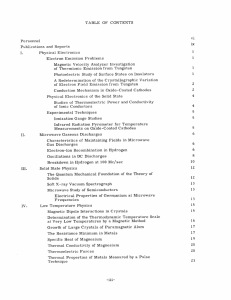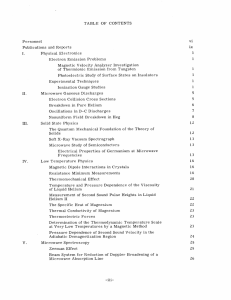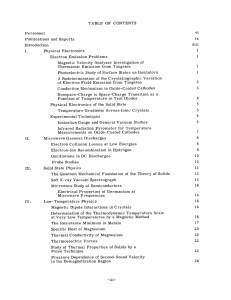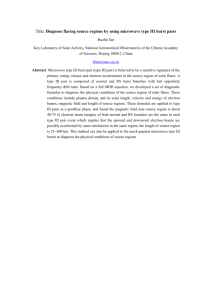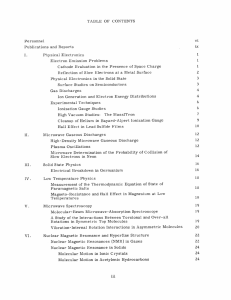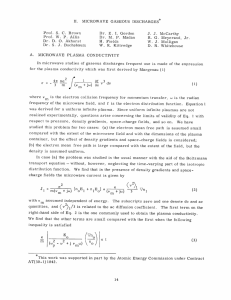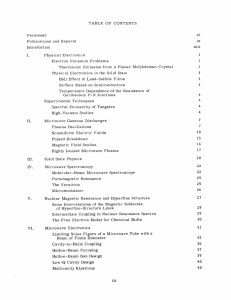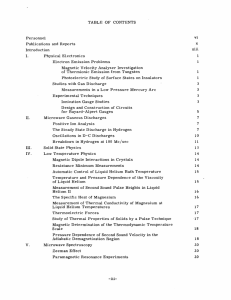II. MICROWAVE GASEOUS DISCHARGES Dr. G. Bekefi
advertisement
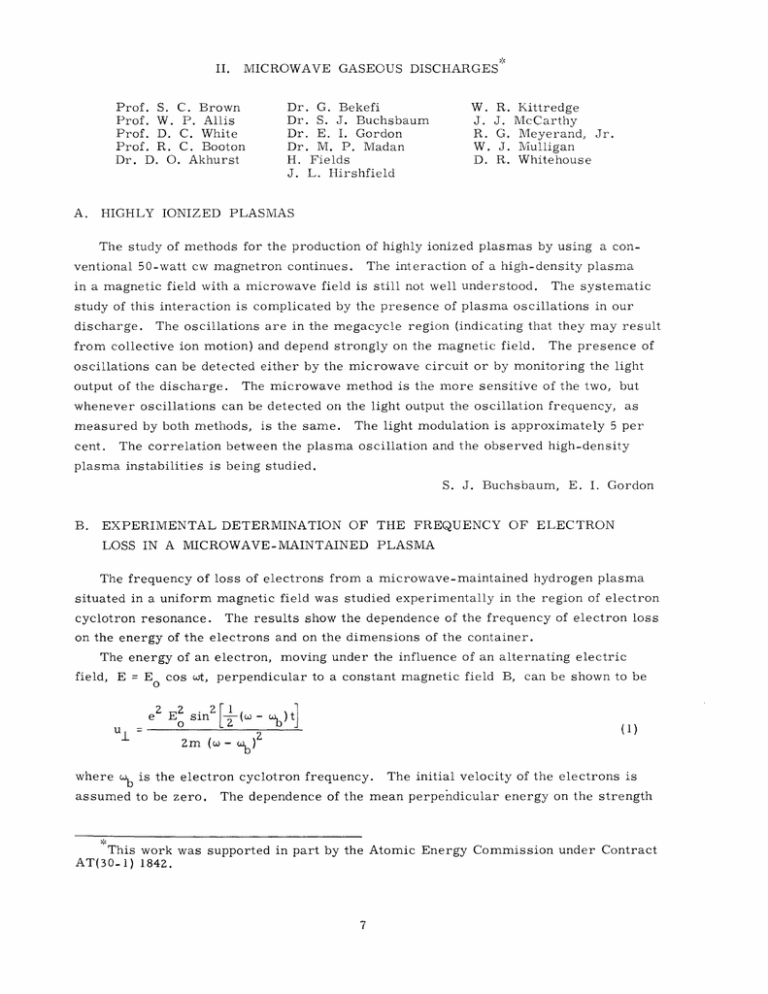
II. MICROWAVE GASEOUS DISCHARGES Prof. S. C. Brown Prof. W. P. Allis Prof. D. C. White Prof. R. C. Booton Dr. D. O. Akhurst A. Dr. G. Bekefi Dr. S. J. Buchsbaum Dr. E. I. Gordon Dr. M. P. Madan H. Fields J. L. Hirshfield W. J. R. W. D. R. J. G. J. R. Kittredge McCarthy Meyerand, Jr. Mulligan Whitehouse HIGHLY IONIZED PLASMAS The study of methods for the production of highly ionized plasmas by using a conThe interaction of a high-density plasma ventional 50-watt cw magnetron continues. in a magnetic field with a microwave field is still not well understood. The systematic study of this interaction is complicated by the presence of plasma oscillations in our discharge. The oscillations are in the megacycle region (indicating that they may result from collective ion motion) and depend strongly on the magnetic field. The presence of oscillations can be detected either by the microwave circuit or by monitoring the light The microwave method is the more sensitive of the two, but output of the discharge. whenever oscillations can be detected on the light output the oscillation frequency, as measured by both methods, is the same. cent. The light modulation is approximately 5 per The correlation between the plasma oscillation and the observed high-density plasma instabilities is being studied. S. J. B. Buchsbaum, E. I. Gordon EXPERIMENTAL DETERMINATION OF THE FREQUENCY OF ELECTRON LOSS IN A MICROWAVE-MAINTAINED PLASMA The frequency of loss of electrons from a microwave-maintained hydrogen plasma situated in a uniform magnetic field was studied experimentally in the region of electron cyclotron resonance. The results show the dependence of the frequency of electron loss on the energy of the electrons and on the dimensions of the container. The energy of an electron, moving under the influence of an alternating electric field, E = Eo cos eZ E t, perpendicular to a constant magnetic field B, can be shown to be sin2 -( - c)t Zm (wwb) where wb is the electron cyclotron frequency. assumed to be zero. The initial velocity of the electrons is The dependence of the mean perpendicular energy on the strength This work was supported in part by the Atomic Energy Commission under Contract AT(30-1) 1842. (II. MICROWAVE GASEOUS DISCHARGES) r= 0.5 CM 2.7 27 r= 1.0 4 0.27mW Ix10 127 270 - ix O3 /0250 F(n >o Z1 250 mW CM) (R .0o 2 S1x10 270 -5 010 J 27 10 1000 1000 1100 1100 1200 1200 B(GAUSS) B(GAUSS) Fig. II-1. Electron energy perpendicular to the magnetic field as a function of the magnetic-field strength in the vicinity of electron cyclotron resonance. Fig. 11-2. Limiting conditions of plasma maintenance as a function of magnetic-field strength in the vicinity of electron cyclotron resonance. of the magnetic field in the vicinity of electron cyclotron resonance, as calculated from Eq. 1, is shown in Fig. II-1 for several values of incident power. The high energies to which electrons may be accelerated in the region of cyclotron resonance are several orders greater than energies off resonance. Experimental results of the dependence of the microwave maintaining conditions on the value of the hydrogen gas pressure and the strength of the magnetic field are shown in Fig. II-2. These results were obtained by the experimental procedure outlined in the Quarterly Progress Report of January 15, 1957, page 17. In the experiments carried out with an incident microwave power of 250 mw, the gas was contained within a quartz tube of 1.0-cm internal radius; the results for other microwave powers were obtained with a tube of 0. 5-cm internal radius. A comparison of the curves for microwave powers of 250 mw and 270 mw shows the effect of increasing the tube radius by a factor of two, the curve for the larger tube being displaced from the curve for the smaller tube by an order of magnitude in pressure. In the vicinity of cyclotron resonance, the (II. MICROWAVE GASEOUS DISCHARGES) 0o w Q") v I Ixl 3 10 3 10 102 u_(ELECTRON Fig. II-3. 10 4 VOLTS) Electron ionization frequency for hydrogen and the constructed frequency of electron loss (for quartz tubes of 0.5-cm and 1.0-cm internal radii) as functions of electron energy. conditions for maintaining the plasma coincide for the higher powers, indicating that the electron energy in the system may be limited. For microwave powers of 2. 7 mw, 27 mw and 270 mw incident on the cavity, the minimum pressure for plasma maintenance is the same, the minima occurring at magnetic-field strengths displaced by nearly equal values from the magnetic field at cyclotron resonance. For a given point on the curves of Fig. II-1, the corresponding value of electron energy can be determined from Fig. II-2. The electron energy and the gas pressure determine the rate at which electrons are produced by ionization, as shown in Fig. II-3. In equilibrium the rate at which electrons are lost is equal to the rate at which they are produced by ionization, consequently the loss frequency associated with each point on Fig. II-1 can be determined. The electron-loss frequency as a function of energy is shown in Fig. 1I-3. The results indicate that the frequency of electron loss for the quartz tube of 0. 5-cm internal radius is greater than the frequency of electron loss for the quartz tube of 1.0-cm internal radius by a factor of 3. 5 to 8. 0, depending on the electron energy. D. O. Akhurst (II. C. MICROWAVE GASEOUS DISCHARGES) HIGH-FREQUENCY BREAKDOWN IN MAGNETIC FIELDS To further our understanding of the loss mechanisms in microwave discharges with magnetic fields, breakdown data for hydrogen were obtained in a TM010-mode cylindrical cavity with a uniform static magnetic field at right angles to the electric field in the cavity. The cavity of OFHC copper (radius, 3. 5 cm; height, Q of 1550. 0. 34 cm) had an unloaded It could be evacuated after bake-out to pressures better than 10 - before admitting hydrogen from the decomposition of uranium hydride. 8 mm Hg In this experi- ment the pressure range extended three orders of magnitude below the published helium data of Lax, Allis, and Brown (1). Break- down was observed either by noting a jump 00- I I I I I in the standing-wave minimum as the dis- I I I _I charge came on and altered the cavity- 1 21 5 950, coupling coefficient, or by observing with a phototube the onset of light from the discharge. 5 75,. - The magnetic-field changes measured with a deflection potentiom- Swere 140 eter that is accurate to four places. Figure II-4 shows the breakdown field 10 -35 strengths as a function of magnetic field -25 35 for several low-pressure runs. Minima for three higher pressure curves, which Breakdown field strengths in hydrogen as a function of magnetic field for various gas pressures. would be quite broad on this scale, are also indicated. Figure II-5 is a plot of the minimum breakdown field strengths -15 -5 0 5 25 15 DEVIATION FROM Bc (GAUSS) Fig. 11-4. as a function of pressure. The effective electric field near resonance (1) can be shown to be proportional to [(C - b) + v -/2, = eB/m is where the cyclotron radian frequency corresponding to the magnetic field B, w is the microwave radian frequency, and v should rise to constant effective Fig. II-6. is the collision frequency. Thus the breakdown curves times their minimum value when w - w = v electric field. in order to maintain a These half-power widths are shown as points in For comparison, the approximate value of vc in hydrogen (2) is also shown. As we would expect, sharp deviations between these two quantities set in when diffusion is no longer the governing loss mechanism, i. e., free path is longer than the tube dimensions. below the pressure at which the mean The mean free path, computed on the assumption of a Maxwellian distribution for the electrons, is = 1/ve (8kT/rm)1/2 For an average electron energy of 3 ev and diffusion assumed along the magnetic field only, the mean free path equals the diffusion length at a pressure of 14. 7 . Hg. This (II. MICROWAVE GASEOUS DISCHARGES) 100 MEAN FREE J 0.0001 0 001 SHORTEST PATH= DIFFUSION LENGTH 0.01 PRESSURE (mmHg) Fig. 11-5. Minimum breakdown field strength as a function of gas pressure. 9 5x10 p 100 10 I MEAN FREE PATH= SHORTEST DIFFUSION LENGTH 0.0001 0001 001 PRESSURE (mmHg) Fig. 11-6. Half-power widths of breakdown curves as a function of pressure. is shown as a dotted vertical line in Figs. II-2 and II-3. We plan to extend these measurements to lower pressures, as well as to repeat them with quartz walls, in the hope of constructing a suitable low-pressure, loss- mechanism theory in these discharges. J. L. Hirshfield, H. Fields References Allis, and S. C. Brown, J. Appl. Phys. 21, 1297-1304 (1950). 1. B. Lax, W. P. 2. S. C. Brown and W. P. Allis, Basic data of electrical discharges, Third Edition, Technical Report 283, Research Laboratory of Electronics, M. I. T., Sept. 1, 1956. (II. D. MICROWAVE GASEOUS DISCHARGES) MICROWAVE DETERMINATION OF PLASMA DENSITY DISTRIBUTION Conventional microwave methods cannot be used to determine plasma electron density at a point, but can be used to obtain an average density defined by n E dv n = = an E 2 (1) dv where E is the probing microwave electric field, and no is the central electron density in the cavity. The coefficient a is known if the electron density distribution is known. In many experiments, especially in those performed in the afterglow, the electron density distribution is not only unknown but also changes with time. In such experiments it is of importance to determine, directly if possible, the dependence of a on time. This can be accomplished if the plasma is measured with two modes whose electric fields have different functional dependences in the plasma region. sider the TE 0 11 and TE 11 1 modes in a cylindrical cavity. a cylindrical post along the axis of the cavity. As an example, con- The plasma is in the shape of When the radius of the plasma is small compared with the radius of the cavity, then, over the radius of the plasma, the magnitude of the E field of the TE 0 1 1 mode is proportional to the radius, and the field of the TE111 mode is independent of the radius. same. The z-dependence of the two modes is the If we assume that the dependence of plasma density on radius can be approxi- mated by the function n = no (1 - r 2 /R 2 )y (2) where R is the radius of the plasma post, then the ratio of the resonant-frequency shifts of the two modes that result from the plasma is AW TE ATE =g TE111 R2 where (1 - r/R 2 ) r 3 dr g + (I - r/R)r (3) dr g is a geometrical constant that does not depend on the density distribution. Hence, from a measurement of AwTE 0 1 1/ TE11, y can be computed, and from it the approximate shape of the plasma density can be computed. the frequency shifts is sensitive to small changes in y. When y is small, the ratio of For example, the ratio changes more than 30 per cent when y changes from zero (uniform plasma) to unity (which, to a good approximation, gives the actual density distribution in a cylindrical tube). (II. MICROWAVE GASEOUS DISCHARGES) The ratio of the frequency shifts can be made even more dependent on y if the two modes are so chosen that, over the plasma region, the field of one mode decreases with radius while the field of the other increases with radius. use of higher modes. Similarly, However, this requires the the dependence of the plasma density on the z- coordinate can be obtained approximately if two modes are utilized whose E-fields are different functions of z but have the same dependence on the radius in the plasma Two such modes are, for example, the TM010 and the TE 1 1 1 region. modes. S. J. E. Buchsbaum PLASMA DIAMAGNETISM Theoretical discussions of the diamagnetic effect of a cloud of relatively free elec- trons in a magnetic field have been carried on for more than forty years but little experimental work has been directed toward observing it (1). is very small. This diamagnetism, if it exists, We shall show that it is observable in high-density, high-temperature Thus, diamagnetism could become useful as a diagnostic tool in plasmas for plasmas. which the conventional methods that use probes or microwaves are unreliable. Probe theory is not adequate when magnetic fields are present, and microwave conductivity measurements are unreliable when the plasma frequency is close to the microwave frequency. Our experiment, which we hope will establish that the diamagnetic effect is observable and determine its validity as a diagnostic tool, is in the preliminary stage. It is well known that a plasma in thermal equilibrium has no diamagnetic effect (2). In the following discussion we consider a plasma that is not in thermal equilibrium. It is an active plasma, in which ionizations occur throughout its volume and recombination with positive ions occurs at the walls of the container. It may also be a plasma in which ionization does not occur, so that the density of charged particles decays with time. either case the controlling loss mechanism is assumed to be diffusion. In We consider that a uniform magnetic field of magnitude Bo is present in the absence of the plasma. The geometry is cylindrical, and the tube containing the plasma is nonconducting and coaxial with the field. We assume that there is only one species of ion, singly charged, in addition to the electrons. The flow of electrons or ions is given by F in which D _ D D . e_ f grad n -D E n (1) ± are the diffusion and mobility tensors for ions and electrons given by and a -b 0 b a 0 0 01 (2) (II. MICROWAVE GASEOUS DISCHARGES) in which D is the diffusion coefficient, and 4 is the mobility in the absence of the magnetic field (3). For simplicity, D and ± are assumed constant, and are given by D = 1/3 ( v)/v c and L = e/m v c , where vc is the collision frequency with neutral or charged particles. The quantities a and b are given by a = v Z / (v 2 + Z, b = awb/c where wb = eB/m is positive for electrons and negative for ions. The density is denoted by n+ and n_. The space-charge field is denoted by E s. The continuity equation for electrons and ions leads to div F' = div F_ = vn_ (3) in which v is either the rate of ionization in the steady state or the rate of decay or build-up in a changing plasma. From Eq. 3 we can write e + -_ = curl H (4) Since the boundary conditions for an insulating container require that the r and z components of the current be zero, we assume that they are zero in the volume of the plasma. We assume that there is symmetry in the 0-direction, and hence that there is no azimuthal space-charge field. We also assume that we are in the limit of large densities where grad n /n = grad n_/n. Equations 1 and 3 lead to the usual solution for diffusion in a magnetic field. There are currents of ions and electrons in the azimuthal direction which produce a longitudinal magnetic field opposite the applied field. It can be shown that 8n (T - -1 + T_) e _ +B + _+ B 2 in which T+ and T are the ion and electron temperatures, and k is Boltzmann's constant. Equation 5 is a good approximation, within the limits of the original assumptions, for densities above 108/cc, for almost any tube of reasonable size. The field at the wall of the tube is B o , and the density is zero. If we write - e - 1 (6) and integrate, we obtain In B/B In B- B - BoB = - o k(T + T_)n If we write B = Bo + 6B, 6B <<Bo, we obtain (7) (II. 4++LB ° 6B nk (T [ + MICROWAVE GASEOUS DISCHARGES) T - ) (8) B = 1 + +4_B o ° In the limit of no interaction between particles and no boundary effects we might expect the reduction in the magnetic field to be given by 6B = -4o M (9) in which M, the magnetic dipole moment per unit volume, is given (2) by to M = (10) onk(T + + T_)/Bo We see that Eq. 8 reduces to Eq. 10 when 4+4_ approaches infinity. collision rate the diamagnetic effect disappears as In the limit of high p+_ approaches zero. For large B, the magnetic field inhibits the radial diffusion so drastically that the diamagnetic effect also disappears. the optimum diamagnetic effect is Ideally, attainable with low- high-density plasmas and at values of the magnetic field Z +4. B2 = 1. For our present purpose, the density of electrons pressure, high-temperature, that are consistent with must be low enough so that the density determined by the diamagnetic effect can also be Moreover, the measurement of diamagnetism in conjunc- determined by other means. tion with a density-sensitive method, such as the microwave method, may offer a means of determining electron temperature. Experiment Two possible methods of detecting the diamagnetic effect are: (a) to measure the change in the magnetic field from a condition of no plasma to a plasma of density n and temperature T; (b) to take advantage of the fact that the susceptibility of the steady-state plasma is a function of the magnetic field. changing plasmas. For example, netic field occurs when Z + _B Eq. = 1. The first method is well suited to rapidly 8 indicates that the maximum change in the magIn a hydrogen discharge in which the ions are close to room temperature and the electrons are energetic, require _B = 4. 6 = eB/mv p in mm Hg). required. If we take v = 1.4/29. 3, and we = 6 X 10 p, we have B = 157p gauss (with At a pressure of 10 mm Hg, a field of approximately 1500 gauss is A flash tube can easily produce a density of 10 of 3 X 104,K. seconds. . ~+p/-_p For this case, 6B - 1.5 gauss. 14 /cc at a temperature The density can build up in a few micro- A coil of 10 turns with a cross-section area of approximately expected to have an induced emf of approximately 0. 10 volt. is At lower pressures, and at correspondingly lower magnetic fields, the effect would be greater. However, the density cannot build up so rapidly at lower pressures, hence the pressure greatly decreased before the effect becomes smaller again. 1 cm 2 cannot be (II. MICROWAVE GASEOUS DISCHARGES) The second method is more appropriate for steady-state plasmas. It is illustrated by the following example. The permeability t of the plasma can be written S- o o - +_ -I 0 onk(T+ + T_) 1 + 4_L+B 2 (11) in which B is the field that exists without the plasma. B = Bo + B1 sin wt, B 1 <<Bo, we obtain, for the permeability, S0 -o o 20 1+ - Bo 4_+3BoB 1 2 sin wt 1 + ~ % nk(T If we apply a field + T_) (12) o_Bo ° It can be shown that the signal introduced by the plasma is V = NAwB I cos t + 1+ Z nk(T + T_) (13) B0 By suitable amplification, the ac signal can be observed. We plan to use both experimental methods; preliminary results indicate that the effect exists. E. I. Gordon References 1. 2. 3. M. Steenbeck, Uber die magnetischen Eigenschaften des Plasmas von Gasentladungen, Wiss. Ver6ff. Siemens-Werken 15, 2, 1 (1936). H. Alfven, Cosmical Electrodynamics (Clarendon Press, Oxford, 1950). W. P. Allis, Motions of ions and electrons, Handbuch der Physik, Vol. 21, 1956; Technical Report 299, Research Laboratory of Electronics, M. I. T., June 13, 1956. F. INHOMOGENEOUS MAGNETIC-FIELD DESIGN 1. Introduction Study of the physics of ionized gases has created a need for synthesizing inhomogeneous magnetic fields with a high degree of accuracy. This problem was considered by L. J. Chu, who suggested a synthesis procedure based on the technique of establishing an analytic expression for the desired magnetic-field solution in a specified region of space. He suggested that the desired fields be generated by current-carrying conductors and magnetic boundaries located outside the region with which we were concerned, and that the magnitude and distribution of the current be determined by using the relation that, at the surface of an infinitely thin current sheet of current density MICROWAVE GASEOUS DISCHARGES) (II. J, n x H = J, where n is the outward-directed magnetic-field intensity. normal of the surface, and H is the He pointed out that current sheets located along lines of equal flux, and magnetic material located along lines of equal potential would provide perfect terminating boundaries for the magnetic-field solution. The accuracy with which the magnetic field can be synthesized by Chu's method depends upon the degree to which the terminating boundaries approximate the assumed boundary conditions. The major synthesis problem is, then, to determine how well the current density J that is produced in finite conductors approximates the current sheets of zero thickness. We could use a current that is distributed over a finite region of space by matching solutions of the Laplace and Poisson equations along specified boundaries. This approach is difficult analytically and will not be discussed. The design of a low-power magnet, which used the Chu procedure, by R. G. Meyerand, Jr. was carried out His experimental results indicated that a small finite distri- bution of current did not greatly affect the fields calculated with idealized sources. On the basis of these positive results, a new design of a higher power magnet was undertaken, which will now be discussed. 2. Specifications Synthesize a magnetic field that is an axially symmetric 1000-gauss field with a uniformity of not less than 0. 5 per cent over a center region of 6-cm length and 1-cm radius, with a ratio of maximum to minimum field intensity along the axis of 5 or higher. Design the magnet for continuous operation. sources: Use one of the following power 20-kw, 2Z0-volt thyratron-controlled rectifier; 300-amp, 26-volt dc genera- tor; or 3000-amp, 12-volt dc generator. Provide four 0. 5-inch holes spaced symmet- rically around the center of the magnet for instrumenting the region of uniform field. 3. Analytic Expression for the Magnetic Field The magnetic field is in free space, and consequently it must satisfy the Laplace equation, VZ7qj = 0, in this region. Since the field is axially symmetric, cylindrical coordinates are the logical choice, and, because of the symmetry in the 4-direction, the scalar potential must satisfy the equation 1 a (r, z) = r r 7 r 8r Z aq + 8z 2Z 0 General solutions of this equation take the well-known form [ = n= 1 (kr) nok + B N( z r) Cnen -kz + Dne (II. MICROWAVE GASEOUS DISCHARGES) The terms in Non(k nr) can be discarded, since 4i and B must be finite at r = 0. magnetic-field solutions corresponding to L are calculated as B = -V7. The For B finite at r = 0, they take the form B =-a r -a z a B + r r -= B = z z + n=l -a A k J(kr) n r n n A J (knr) z no n C k e nn C e n + D -D k nn en n The Bz component of the magnetic field must increase for z that is appreciably removed from z = 0, and it must be symmetrical about the point z = 0; hence Bz must be an even function of z. This condition can be met for both real and imaginary values of k. Con- sequently, allowed solutions of q and B take the general form: 00 A' JJ(k r) sinh (knz) + B' I (k r) sin (knz n=l B = S Kr A' k Jl(knr) sinhk z - B' k I (k r) sin k z nn n n nn n n n=l -az A'k J (k r) cosh k z + B kIlo(kr) cos knZ } In the field solution which these general solutions must satisfy BZ is very uniform over a region of space around r = 0, z = 0, and increases rapidly for z that is outside this uniform region. One way to obtain this result is to define the desired field dis- tribution, make a Fourier expansion of the field along the z-axis, and match coefficients with the general expression. However, a much simpler field solution that meets the desired conditions can be obtained by observing the variation of B r and B z along the z-axis (r = 0) and along a radius at z = 0 for small values of z and r. Thus the four following relations characterize the variations of B for small r and z: C0 A' sinh k z - B' sin k z n n n n n=l for r = 0 0A A' cosh k z + B' n n=l n n cos k z n (II. A' Jl(kr) n n MICROWAVE GASEOUS DISCHARGES) - B' Il(knr) n n n=l for z 0 A' J (k r) + B' I (k r) non n n=l From a power-series expansion of the eight functions sinh kz, Jo(kr), and Io (kr), it follows that if A cos kz, J (kr), I1(kr), variations in B r and B z and k = k, the around r = 0 and z = 0 become Z(kz)3 sinh kz - sin kz =3! 2(kz) 7 +-7! 2(kz) 4 for 2(1 8! 4! 2(kr/2) r = 0 A =B n n k = k n cosh kz + cos kz = 2+ J(kr) = B sin kz, cosh kz, 3 Z(kr/2) 7 - I (kr) = 1!2! for 3!4! z A 2(kr/Z) J (kr) + I (kr) = 2Z+ 4 2(kr/Z) 8 k + Z!2! n n 4!4! These equations show that if only two terms in the power-series expansion for the magnetic field are kept, the first important term in the variation of the B the z-axis is (kz)4/4!. small z and r, 4 Along a radius at z = 0 it is (kr) /2!2! . component along Clearly, then, for a uniform magnetic field can be obtained by using the simple scalar field = A[J (kr) sinh (kz) + Io (kr) sin (kz)] which gives a magnetic field B = Ak ar[Jl(kr) sinh (kz) - 1(kr) sin (kz)] - az[Jo(kr) cosh (kz) + Io(kr) cos (kz)]} This particular expression for the magnetic field has the advantage of analytic simplicity, excellent uniformity of Bz around z = 0, r = 0, and a very rapid increase in Bz for large z. Thus a magnet can be designed for good uniformity over a central region (II. MICROWAVE GASEOUS DISCHARGES) and a large ratio of Bmax to Bmin mm without being excessively long. 4. Evaluation of the Magnet's Boundary Condition Choice of the principal dimension of the magnet is somewhat arbitrary, since many configurations will meet the specifications. The main problem in a large magnet is the total power consumed, and this power is reduced (within limits) by minimizing the dimensions. The dimensions chosen were, approximately, an 8-cm radius and a 60-cm length for a Bma x to Bmin ratio of 5. This gave a B uniform within 0. 5 per cent over a region of approximately 11 cm along the z-axis and of 6-cm radius at z = 0. Since this uniform-field region was twice the desired size, a smaller magnet could have been designed. After considering possible difficulties in construction and the effects of finite current distribution, the factor of 2 in the size of the region at uniform B was kept. The desired magnetic-field strength at the center of the magnet is (0. 1 weber/mZ), and a ratio of B to Bmin of at least 5 along the axis at 30 cm from mm The field solutions that satisfy these conditions are: the center is desired. =-0.05 B = -74 1000 gauss max .Ji(kr) sin (kz) + Jo (kr) sinh (kz)- = 0. 05 ar[Il(kr) sin (kz) - Jl(kr) sinh (kz)] + az[Io(kr) cos (kz) + J (kr) cosh (kz)]} where k = r/0. 3, and r and z are in meters. With the B field determined, the boundary condition can be established. A current distribution that will produce this field can be evaluated by finding the magnetic-field intensity along constant-flux contours of the scalar flux field D. The constant-flux contours are determined by recognizing that the constant-potential contours of constant-flux contours of 1 are orthogonal. These two orthogonal fields must also satisfy the condition that their gradients are orthogonal; that is, V74 • V. simple way to find the scalar flux field 'D One Thus r B - da= 0 = 0. is to recognize that it is the measure of the flux that passes a cylindrical surface normal to the z-axis. r 4 and B z Z rr dr 0 For the value of B chosen, the scalar flux field becomes simply 0 = 0.03 rI1(kr) cos (kz) + rJl(kr) cosh (kz)} This scalar flux field can be shown to satisfy the orthogonality condition 7 7 V = 0. (II. MICROWAVE GASEOUS DISCHARGES) The surface contour of the magnet was determined by a line of constant 1, and the constant-flux surface that intersects the point z = 0, r = 0. 08 meter was chosen. gives a flux surface of ( = 0. 0020158 weber or 201, 580 lines. cal magnet design were determined by finding the contour for 1 This The data for the practi= Cs = 0. 0020158 and s the magnetic-field intensity B3 H z o s s evaluated along the constant-flux contour s . These data are plotted in Fig. II-7. Design 5. The calculations illustrated in Fig. II-7 show that, at z = 0, 8000 amp/meter length is required. a current of At z = 0. 30 meter, the required current is 36, 000 amp/meter length, which gives a Bmax/Bmin ratio of 5. 3 on the z-axis. At z = 0. 35 meter, the required current is 64, 500 amp/meter length, which produces a Bmax/Bmi n ratio of 9. 3 on the z-axis. These currents are obviously very large and hence, if the conventional figures of 150, 000 to 300, 000 amp/meter 2 were used, copper thicknesses as large as 0. 5 meter would be required at the end of the magnet. such thickness is impossible on simple physical grounds. Any Moreover, the current den- sities were calculated with the assumption that the current sheets are infinitely thin, CONTOUR OF 8x 05 s = 201,580 LINES 008 7x 105 6 x 10 5 x 10 S4xIO 5 3x 10O 2x 10 0.18 z-AXIS (METERS) Fig. II-7. Constant-flux contour and axial current density. (II. MICROWAVE GASEOUS DISCHARGES) and any thickness of copper that distributes the current over a region of the same order of magnitude as the major dimension of the magnet would not approximate the calculated field solution. The amount of copper needed to carry the current is determined primarily by considering the heat dissipated in I R in the windings. The elimination of heat from the windings is essentially a problem in heat transfer across the insulation around the copper wires to an exterior surface which dissipates the heat by radiation, convection, and conduction. The problem of heat transfer can be simplified by keeping the thickness of the insulating boundaries between heat source and heat sink minimum. This problem was best solved by using a single-layer magnet energized from a high-current, low-voltage source. The single-layer design has only one 0. 001-inch insulating barrier between the heat source and the heat sink. An average heat conductivity of insulating materials is 0. 001 watt-cm/oC; therefore, across a 1-cm surface that is 1 mil thick (0. 00254 cm), a thermal power transfer of 0. 4 watt/oC can be obtained. This heattransfer figure is very attractive and indicates that a single-layer magnet with very high current densities would not exceed 100°C to 150'C rise in the hottest parts. This has still to be checked experimentally. The design of a single-layer winding to produce a continuously varying current along the axis of the magnet presented some difficulty. The simplest solution was found by varying the width of each turn along the axis of the magnet so that a constant value of total current approximated the desired current distribution. Calculations on the basis of a 2000-amp source led to conductor sizes of I inch maximum width in the center of the magnet to 0. 1 inch minimum width at the end of the magnet. These dimensions were reasonable, and, since a 3000-amp, 12Z-volt generator was available, a figure of 2000 amp to produce 1000 gauss at the center of the magnet was chosen. The width of successive turns was calculated from the curve for Hz shown in Fig. II-7 by the relation I = 2000 = IH dz z1 The widths for each turn obtained from these calculations are included in Table II-1. Taking into account the maximum power available from the generator, the heat transfer across a surface of approximately 0. 4 watt/cmZ/o C, and the copper thickness that would reasonably approximate a very thin current sheet, we chose a copper thickness of 0. 35 inch over the length from z = 0 to z = 30 cm, which gave a B max/Bmi n ratio of 5. 3. The section of the magnet between z = 30 cm and z = 35 cm was designed with a copper thickness of 0. 5 inch, since this section was far enough from the center where the uniform field is desired so that the additional thickness would not be MICROWAVE GASEOUS DISCHARGES) (II. Copper Winding - Table II-i1. The section from the magnet ratio can be thickness increased 35 30 cm to operated 0.080 0.080 0.080 0.080 0.080 0.07771 0.07384 0.06884 0.06371 0.05906 0.05504 0.05163 0.04872 0.04622 0.04405 0.04216 0.04050 0.03902 0.03769 0.03650 0.03540 0.03442 0.03350 0.03267 0.03189 0.03116 0.03050 0. 02986 0.02927 0. 02872 0.02819 0.02769 0.02723 0.02679 0.02636 0 0.02502Z 0. 05028 0. 07600 0. 10208 0. 12792 0. 15228 0. 17399 0. 19263 0.20846 0.22201 0. 23374 0. 24406 0.25325 0.26152 0. 26903 0.27592 0.28228 0.28818 0. 29369 0.29886 0. 30372 0. 30832 0.31268 0.31683 0. 32079 0. 32456 0.32817 0.33164 0.33497 0.33818 0.34128 0.34426 0.34715 0.34995 0 1 2 3 4 5 6 7 8 9 10 11 12 13 14 15 16 17 18 19 20 21 22 23 24 25 26 27 28 29 30 31 32 33 34 This r(meters) z(meters) Turn No. detrimental. Dimension of Each Turn. cm was with a appreciably designed Bmax/Bmi n reduced the as a dissipated section, so that removable ratio of 5. 3 or power. a B max/Bmi n of 9.3. The outside surface of the current sheet is simulated by an iron boundary. magnet on equal-potential lines. an equal-potential line which was Iron boundaries were placed across both ends of the The total flux enclosed by the magnet is approximately 200, 000 lines for 1000 gauss in the center. To prevent saturation, the magnet was designed with a 0. 25-inch iron shell from z = 0 to z = 30, and a 0. 5-inch shell from z = 30 to z = 35, with end caps 1 inch thick. The copper windings were fastened to the iron shell by a thin layer of insulating varnish (not more than 1 mil thick) that holds the copper winding and iron shell together as one structural unit. The heat is conducted from the copper across the insulation to the iron; water-carrying conductors on the surface of the iron take the heat away. The total power dissipated is 10. 5 kw for a Bmax/Bmi n ratio of 5. 3, or 18. 5 kw for a Bmax/Bmi n ratio of 9. 3. mately 1. 5 gallons/minute. 0 The maximum water flow for a 50 C rise would be approxi- See Fig. 11-8. (II. MICROWAVE GASEOUS DISCHARGES) ON SURFACE I-MIL INSULATING BOUNDERY 006 005 004 003 002 11 004 006 11 008 I -__H 010 0.12 0.14 I 016 _ 018 I 0.20 I _1 I 022 024 0.26 I _ 028 030 1 0.32 z-AXIS (METERS) Fig. II-8. 6. Cross section of magnet with copper winding and iron shell. Construction The general construction of the magnet is quite simple, with the exception of the single-layer winding. The winding was constructed by building a form of hardwood covered with wax. The turns were placed along the axis of the form, with small insulating spaces 10 mils thick. The winding was electroplated on the form. This produced a stress-free winding with the insulation already in place between the turns. The winding was machined on the outer surface to match the iron boundary and fastened to the iron with insulating varnish. The winding and iron boundary forms a single structural unit. The magnet is being constructed; final details will be reported later. D. C. White
